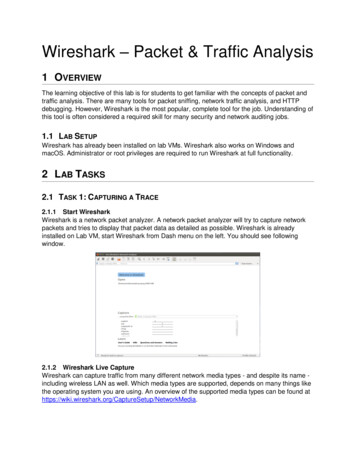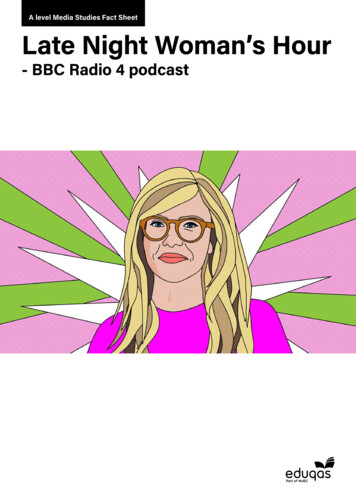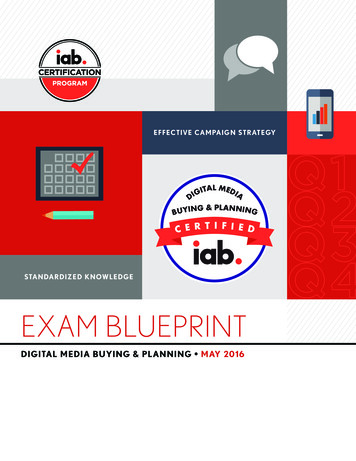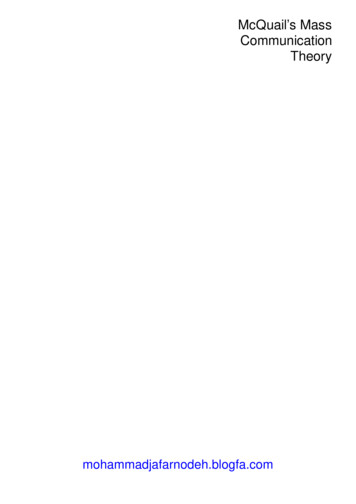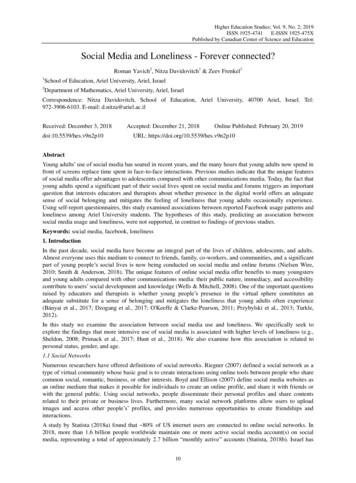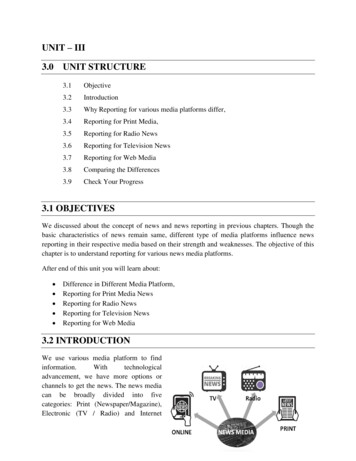
Transcription
UNIT – III3.0UNIT STRUCTURE3.1Objective3.2Introduction3.3Why Reporting for various media platforms differ,3.4Reporting for Print Media,3.5Reporting for Radio News3.6Reporting for Television News3.7Reporting for Web Media3.8Comparing the Differences3.9Check Your Progress3.1 OBJECTIVESWe discussed about the concept of news and news reporting in previous chapters. Though thebasic characteristics of news remain same, different type of media platforms influence newsreporting in their respective media based on their strength and weaknesses. The objective of thischapter is to understand reporting for various news media platforms.After end of this unit you will learn about: Difference in Different Media Platform,Reporting for Print Media NewsReporting for Radio NewsReporting for Television NewsReporting for Web Media3.2 INTRODUCTIONWe use various media platform to findinformation.Withtechnologicaladvancement, we have more options orchannels to get the news. The news mediacan be broadly divided into fivecategories: Print (Newspaper/Magazine),Electronic (TV / Radio) and Internet
(Online news portals / websites). Different media deliver us the news differently, though the coreinformation and basic journalistic values remain unchanged. The difference is in use of style andformat in packaging and distribution of news.In this unit we will learn about the difference in news coverage for various media formats likeprint, Television, Radio and Online media. We will discuss about basics of language and styleused in reporting for various media platforms.3.3 WHY REPORTING FOR VARIOUS MEDIA DIFFERSame news can be reported in different ways in various media platforms, though they apply theuse of the characteristics of news when writing stories. The difference in reporting is not becauseof the happenstance, but because of the demand of the medium and the target audience. Forexample, the print media relies more on words and photographs, whereas the television newsrequires visuals or videos, the radio news is delivered in the form of sound and the online newscan present the news using all word, video, audio and photographs. In print news, where space isthe concern, a sentence can be about 20-25 words, whereas in broadcast news, where time is aconcern, a sentence usually contains 10-15 words. Similarly, People don't read information onthe Web in the same way as they read a newspaper or watch television or listen to the radio.Unique nature of the medium and the way in which it is received by the public demandnewspapers, radio, television and online media to adopt different reporting style. For example,we receive a newspaper everyday and it remains unchanged throughout the day. We can rereadthe story as much as we want. But in case of Television or Radio, the timing is important. Thenews need to have immediate feel. Reporting must be done on things that are happening now.Each news medium embodies a unique regime of content creation.The processing of news in our brain is different in case of broadcast media and that in anewspaper / online media. Broadcast media like TV or Radio give only once chance to see/hearand understand the story. If anyone misses the particular visual, in case of TV, or audio, in caseof Radio, then the whole news may not be understood. Whereas in case of the newspaper, evenonline media the reader can linger over a story or go back and re-read if something is not clear.For a journalist working for TV News or Online media, every minute is deadline because,because news broadcasts could be made at any time of the day. However, for a newspaperreporter the deadline is fixed, since newspapers are printed once a day. This gives more time tothe newspaper reporter to write their story and more in-depth reporting. Similarly, the Televisionhas the advantage of showing video and hence required fewer words than print. Websites newsreporting can cover text, audio, and video information, all of the ways traditional media aretransmitted. Unlike the television or newspaper, the web news portals have more interactiveapproach by allowing people to personally tailor the news they receive via various tools.
Different media has different approach to influence their respective audience. In television news,the tone of the voice, physical build, gender and dress all influence the audience’s perceptions ofauthenticity and accuracy. Similarly, in radio news the tone of the voice has the influence. Peopleform perceptions immediately based on what they see or hear. But in case of print media andonline media, readers are unaware of the physical characteristics of the reporter. (Some onlinemedia are giving photograph of the reporter, but not prominently.) Only thing they can know isthe gender of the reporter from the by-line. Here the reporting skill and quality of informationthat counts to influence the audience.3.4 REPORTING FOR PRINT MEDIA & NEWS AGENCIESPrint media which includes newspapers, magazines and other printed news source is the oldestmedia form. Although print media readership is declining across the globe, many people stillread a newspaper every day or a newsmagazine on a regular basis. The importance of printmedia is therefore significant. Regular readers of print media are more socio-politically active.Since print media is used by people who can read and write, the print media readers are mostlyeducated.Print media gathers, processes, and produces news in a one-way daily delivery. It has fixedfrequency of delivery like a newspaper delivered / produced once a day and a magazine isproduced / delivered once a week. It has opportunity for geographical selectivity thus covering aparticular geographical region intensively. Since people get it physically and have opportunity toreread, print media helps in communicating complex information. On the other hand, print mediahas the limitation of using sound and motion. Messages in a newspaper compete with each otherto draw the readers’ attention.A Newspapers Report is written so that it may be edited from the bottom up. It has the fixedspace. So, what doesn’t fit is thrown away. The reader scan the headlines on a page, beforereading a story. If the headline creates interest, the reader goes to the first paragraph. If that alsoproves interesting, the reader continues. The readers have the luxury to select the page or news togo through, skipping others in a newspaper.As discussed in previous unit, the basic structure of aprint media report consists of three main elements:Headline, Lead and Body. Hard news does not have anyconclusion. The headline has to be very good andappropriate to create readers’ interest. Active andmeaningful verbs should be used in writing the headline.Articles and helping verbs should be avoided. It isgenerally written in present tense and future tense as faras possible and in active voice. Certain parts of direct
speech, which are significant enough, can be used in the headline. It is put in single quotes.The lead or intro is the next important part after headline, in print news. In most hard newsstories, the lead contains the most important information and summarises the story. It usuallycontains the most important of the 5 Ws and 1H. The lead has to be very precise and pin pointed,and the language crisp and easily understandable. Action verbs should be used to give the readerthe best picture of what happened. We have discussed various type of lead in the previous unit.The details of the news story are given in the body of the news. Most of the hard news is writtenin inverted pyramid style, which we have discussed in the previous chapters. This style isimportant for both editing and reading. Accordingly, the more important details are in the earlypart of the news and the less significant details are placed towards the end, in diminishing orderof importance. The body of the news is mostly written in present tense in order to emphasizetimeliness. When a news stories that speak about events that will take place in the future are,auxiliary verb is used. In stories where the actual time of an event is not known or is notimportant, the present perfect form of the verb is preferred.Print journalism edits more than the broadcast. Newspapers edit for clarity, fairness, andaccuracy. They also edit to ensure individual house style. The extensive editing process in printjournalism allows more time for eloquence and prose. Broadcast and print journalism also differin structure. Print news stories use an inverted pyramid structure with the most important items(the facts of the story) reported in the first paragraph. Remaining facts are then presented indescending order of importance. Lastly, broadcast and print news stories differ in length andpace. The average print new piece can vary greatly in length, the reader who dictates the pace ofreading. Since print media is geographically specific, news from a particular geography getspriority in such media.However, unlike print media, a news agency does not publish any newspaper of its own. All thenews is transmitted to the newspaper and other media outlets. Speed and accuracy is highlyimportant in news reporting for a news agency. For a News Agency Reporter, the deadline isevery minute, the reporter has to file the story as soon as important. Though the reportingstructure is same as newspaper reporting, all the news items have to be quoted from someone andshould be based purely on factual reports. There is hardly any space of comments orinterpretation. The report should be precise and to the point. A newspaper can confine toreporting local stories, based on its geographical coverage, but a news agency cannot limit itselfto a particular locality.3.5 REPORTING FOR RADIORadio is oldest news medium, after print media and us accessible to wider sections of the society.Even people who cannot read or who are staying remote part of the country can access radio
news. It is available in villages as well as in cities. According to UNESCO It is “the massmedium that reaches the widest audience in the world”.Compared to newspapers and television, radio is inexpensive to produce and distribute. it is alsothe easiest form of broadcasting to produce. Anyone with an ability to talk can take part in aradio broadcast. It can transmit on a local level, in regional language, addressing issues ofimportance to local listeners. It can be interactive using telephone or SMS.However, the radio newscast is consumedsequentially. Listeners have to wait. Evening if,listeners is bored by one part of the newscast,they cannot skip forward to the next segment ornews. If they are interested to listen to the fifthstory they have to listen the first four stories. it’slike eating in a restaurant in which each dish isserved in a sequence. One has to eat each courseas it is presented. If one does not like a dish, heor she must wait for the next course to be served.So the stories in a radio newscast need to bechosen and made to be interesting to a significantnumber of listeners.Similarly, in a radio newscast if a news report is confusing, the listeners cannot rewind and reread the story as it happens in case of newspapers. They have to comprehend the news at once.They cannot go back. That’s why, clarity in both sentence length and word choice is important inradio news reporting.Radio of course needs reporting that is for the listener’s ear, rather than the reader’s eye;sentences must be crisp and short. In radio, a complete story is called ‘wrap’ and its durationvaries from 30 second to 90 seconds. It includes of the reporter’s narration, also called “track,”and often includes sound bites and natural sound, sound that occurs naturally on location. Thescript contains less information than a print story, so the picture building is very important.The radio report with audio is an informative bulletin about current affairs and does not includesopinion. The reporter speaks during the report – providing the voice-over. The addition ofvarious pieces of recorded material (known as audio clips, cuts, or sound bites) makes the reportmore lively, authentic, and interesting. These additional pieces can be statements frominterviewees, statements made at press conferences, or other recorded material.Unlike newspaper readers, radio news listeners are hardly, attentive. Usually, people listen toradio while doing something else. The radio listeners are often driving, working, or engaged insome task other than absorbing the latest news. Hence radio news stories are told in familiarwords combined into sentences, which run at comfortable lengths in a conversational style.
Guidelines suggest writing as if telling a story to a friend who is trying to catch a bus that isready to pull away.Unlike the readers in a print media, it is often found that the listeners of radio news hear thewhole story from beginning to end. Therefore, although it is important to give key information atthe beginning of the story, we can spread out facts to keep the listeners interested from the startto the end of the story. Radio news is shorter than newspaper news and hence requirescomprehension and filtration of facts while writing the news.As in case of newspaper, the lead in a radio news introduces the listeners to the broadcast itemthey are about to hear – whether this is a news report, interview, bulletin, or longer report. Itfocuses on the essence of the broadcast item to follow, avoiding too many facts and figures. TheRadio lead consists of three parts. The “ear catcher” should arouse the interest and curiosity ofthe listener. Then there is an introduction that broadly addresses the topic that the followingreport will cover; this part of the lead-in will also connect the radio presenter to the report andthe rest of the radio program. There are several approaches one can take to writing the lead-in. Itcould be written in a news style and stick to the facts. But if the broadcast item to follow is moreconversational or casual, then the lead-in can be more creative – for example, it could containmetaphors, examples, comments, questions, or interesting contradictions. The presenter usesbasic storytelling principles and can be freer in how they introduce the item. However, thecontent of the lead-in should always have relevance and appeal for the listeners and it should notdouble up on any of the information in the actual broadcast item.The radio news writing style includes the choice of simple words with short declarativesentences, since the listeners have no opportunity to go back and hear it again. Sentences in aradio news story generally contain just one idea and do not contain multiple clauses and internalclauses. Jargons or highly technical words are also avoided. Attribution precedes statements as itdoes in normal conversation. Sentence structure is incomplete at times, such as sentences withoutverbs. Understanding is more important than grammar to a radio news reporter. The wordsshould sound natural when read. Complicated figure can be told in simplified way like there willbe no harm if a radio news reports like 1995429 as almost twenty lakh.3.6 REPORTING FOR TV NEWSTelevision uses both audio and video to communicate the message. It is important that the wordsand pictures match and that they don’t give different messages. It is similar to radio newsreporting, added with video. Like radio news, television viewer has no control over the pace ofreporting. They cannot go back to the story to see or listen it again. As said by former CBS (U.S.TV network) News editor Ed Bliss, “The words are spoken and, once spoken, are irretrievable”.Lack of editing, in comparison to print media, demands short, sharp, succinct language of a moreconversational tone in television news reporting. The format for the story always may not be
inverted pyramid style; important facts are still reported in the first paragraph. It ends decisivelyand do not trail off as do print news stories. Like Radio, the most of the viewers watch the newstill its end. The average television news story is one minute and 30 seconds long. Read at a paceof 180 words per minute these lengths equate to 90 and 270 words respectively for radio andtelevision news stories.A television report begins with a general, simple sentence signalling the beginning of a story. Itconsists of reporter’s narration or voice over and video, which may include graphics, either staticor animated. Each story has a lead or intro, which captures the essence of the broadcast item tofollow. The lead contains important information the viewers will need in order to understand thenews item to follow. It can come in various shapes and formats depending on the context andcontent of the news item. A lead-in can be very news oriented, limiting itself to facts. But if thebroadcast item to follow is more conversational or casual then the lead-in can be more creative.The reporting follows the basic storytelling principles. The lead may not always include 5 Wsand 1H as it would make it too long and too hard to follow. The two or three most significantpoints may be selected and used in the lead. Rest can follow the lead.Sentences in a TV news story should contain just one idea and avoid multiple clauses andinternal clauses to make easier for the anchor to read and for the viewer to understand. Shortersentence are used so it can be read aloud without running out of breath. Reporters for radio andtelevision must be attuned to the sound of the words they use. It is also important to spellcorrectlyforTVnewscoverage.Misspellings may result in stumbles ormispronunciations on the air. The writing ismore conversational than that in print. It iswritten in the way the audience speak. Tomaintain a conversational tone, TV newsreports don’t need to use complete namesand titles in news stories. Generallyspeaking, middle initials are not used on theair unless the initial is an essential part of thename. Attribution can come first. Immediacyis a key feature of television news.The bites used in television reporting are equivalent to the quotes used by newspaper reporters.This must be carefully selected. It should be clear enough to understand. In addition to soundbites, stories on television can include ‘natural’ or ‘wild’ sound, which is captured whilereporting a story. Using this sound in telling the story allows listeners or viewers to experience aplace or situation for them, instead of the reporter telling them about it.Video is an essential part of television news reporting. It is combined with words to make thestory powerful. The visuals tell the ‘what’ of the story, whereas the words tell the ‘why’. It is
said that ‘seeing may be believing but it isn’t understanding’. The writing should besynchronised with the video. It is found that viewers understand and remember stories muchbetter when the words and video match. When the video and words do not match, they surelyfight each other for the viewer’s attention, making it difficult for the viewer to understand thestory. Also matching the video and word does not mean that reporters should simply describewhat the viewer can see. Instead, the audio track should offer information that adds context andmeaning to the picture.Usually, news for television is written after viewing the unedited video tape. This helps inlogically arranging words and visuals. All of the fresh information is given in the words, but it isthe pictures that carry the impact for the viewers. For some stories like economy, in which freshvideo is not available, file tape and graphics are chosen to explain the story. Numbers can bepresented by using graphics such as graphs, pie charts or other visual aids.3.7 REPORTING FOR WEB MEDIAThe web or online media combines the features print as well as broadcast media, besides havingits own attribute. It allows the users to read a news story, examine its sources, and interact invarious ways. An online news report can include audio clips from interviews, text of governmentrecords, and interactive maps that all can change the way a reader understands a story.Interactivity is one of the unique features ofOnline Media. User can give their feedback orchoose story to read. Almost all news sitesprovide space for readers to post theirfeedback or opinions, which others can alsoread and respond. Another feature of onlinemedia is ‘multimedia’, a form of presentationthat uses audio, video, graphics, or othermethods to give users different pieces of astory. Interactivity and multimedia capability is integrated features of the online media andsignificantly influences the news reporting.Online media can reach a very wide audience and offer enormous space to for news writing. Likebroadcast media, every minute is a deadline for online news reporter. Similarly, unlikenewspapers, news published in online media can be rectified or updated instantly. Though likenewspapers, online media offers news stories to be read, writing for newspapers and onlinemedia is not same. Online news readers not only read the content, they interact with it. Onlinemedia is not static or way as print media. It allows the audience to select a video clip or visit adocument through hyperlink. It makes the audience active participant.
Also consumption of news in a web portal is not same as that in a print media. In print media, thejournalist knows what they've read previously, and what they're going to read next. Details canbe given in a logical sequence. But in case of internet news users ignore the details to readcontent faster. It has been found that most of the users scan the page instead of reading word forword, focusing on headlines, summaries and captions. If the quick scan doesn't show them theinformation they need, they won't spend time searching for it. Instead of in depth reading theyprefer short paragraphs. The longer the text, the less likely Web users are to read it. This isbecause reading from a computer monitor is 25% slower than reading from print and it eye strainand fatigue.While reporting for an online media, multiple levels - words, ideas, story structure, design,interactives, audio, video, photos, news judgment – should be considered at once. TV is aboutshowing the news. Print is more about telling and explaining. Online is about showing, telling,demonstrating, and interacting.The most basic form on a online news story is described as ‘print plus’. This means a text storylike that in a print media with additional elements like photographs, audio, and video, orhyperlinks to more information. By using hyperlinks, the readers can be taken to additionalinformation on separate web pages, some of which may be provided by sources outside the newsorganization, with more background or history.A more innovative approach is to use ‘clickable interactives’ or multimedia graphics specificallydesigned to illustrate a story. The graphic elements are laid out in linear fashion, but the readerhas the liberty to explore them independently in any order.Online news writing is a hybrid of both print and broadcast writing. Short and simple style usedby broadcast media is suitable for online media. A conversational tone like broadcast media isgood but grammar and spelling still matter in online media.Headlines, subheads, and teasers play a more important role in online news reporting. Theyshould be enticing for the readers to click on the story and read more. They must also containseveral key words, or tag words, so that the article can be found by search engines. The firstthree words of the headline must have information about the content, because users often scandown the left part of a list of items in a web news portal. They never see the last words in a linkunless the first few words attract their attention.The lead of the news should quickly indicate what a story is about. Delayed or anecdotal leadsmay divert the user to click on another story. Though online media has enormous space, thestories are, usually shorter than newspaper stories. a typical online news story is about 800 wordsand is given in one page. Using subheads and bullet points helps in online news reporting. Thecontent should be brief and actionable.
Another important aspect of online news reporting is search engine optimization (SEO). SEOrefers to a process in which the writer will use specific keywords in a particular order on the pagein the hopes that the search engines will ‘pick up’ the article and rank it higher in the searchresults. Though this limits the flexibility in writing and word choice, it is important in order toachieve the highest amount of readability possible while retaining the overall theme of thearticle.3.8 Comparing the DifferencesFrom above discussion, we find that though the basic journalist principles remain unaffected,each medium has its own style of news reporting as per their respective features. With changingmedia environment and interest of audience each media type is trying to improve and blur theline of distinction. For example, after witnessing fall in circulation, newspaper now have statedusing less formal style. Online media is integrated with newspaper or broadcast new reports.Sl.No1.Print MediaRadioTelevisionUses wordsUses words (Sound)2.Fixed Deadline3.UsesAudience4.Mostlyfollows Givesmostinverted pyramid style important thing first5.Gives opportunity for No opportunity forrewind / rereadgoing backConstrained by Space ConstrainedbyTimeCan include complex Uses simple andsentencesbrief sentencesReaders can choose Listeners need tothe story to readwait for their storyUseswords Used Multimedia(Sound)& (Words,Sounds,Pictures (Video) Pictures,videos,graphic)Every minute is EveryminuteisdeadlinedeadlineCanhave Has educated audienceilliterateaudienceGivesmost Gives most importantimportant thing thing firstfirstNo opportunity Gives opportunity forfor going backrewind / rereadConstrained by Constrained by Readers’TimeattentionUses simple and Uses simple and briefbrief sentencessentencesViewers need to Readers can choose thewait for their story to readstoryInteractiveVery highly interativeUnderstandingNeeds correct grammarof audience e and spellingimportantopportunity for Uses graphic to explainusing graphicssomething6.7.8.9.10.11.Every minute isdeadlineEducated Can have illiterateaudienceLess InteractiveInteractiveNeedscorrect Understandingofgrammar and spelling audienceeimportantUsesgraphicto No opportunity forexplain somethingusing graphicsOnline
Choice of news stories, their length, and the choice of leads is important in all the media type. Itis the responsibility of all type of media give people the news they want, and that is relevant tothem.Check Your Progress:3.1 How different Media Platforms require different style of reporting?.3.2 Why writing for online media is different from print media?.
3.6 Reporting for Television News 3.7 Reporting for Web Media 3.8 Comparing the Differences 3.9 Check Your Progress 3.1 OBJECTIVES We discussed about the concept of news and news reporting in previous chapters. Though the basic characteristics of news remain same, different type of media platforms influenc


